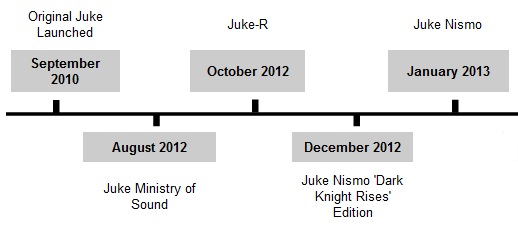The product life-cycle (below) for a given product consists of introduction, growth, maturity and decline. Given that the product is most profitable during the maturity phase, marketers want to extend that phase for as long as possible.

One of the ways of doing this is, as the above graph demostrates, is through the use of extension strategies. Extension strategies employ the use of Market Penetration or Product Development strategies (see Ansoff’s Matrix) to delay the decline stage as much as possible. If the former is used, often the price may be lowered or a new marketing campaign is commissioned; if the latter is undertaken, an adjustment is made to the product to give it a ‘refresh’.
Although Market Development can achieve similar – if not greater – levels of sales by taking the product into a new market, it is not an extension strategy as the product will still enter the decline phase in its original market.
But how does this relate to, Nissan’s crossover car, the Juke (below)?
Well, Nissan have used unconventional extension strategies – to extend the life of the Juke – which I feel are worth exploring. Many people believe that all extension strategies follow like Apple’s iPads or Sony’s Playstations: that is, #1 product is launched, then replaced by #2 product, then possibly #2 product thinner / more colours edition, then #3 product and so on and so on.
Product extensions, however, do not always follow this pattern – particularly, Nissan’s Juke. Namely, each product update serves not to replace the preceding product but to increase the originals sales at the expense of the new product, which is akin to a loss leader.
Here is a time-line of the Juke’s extension strategies and quick summary of each new update:
- Juke Ministry of Sound – updated with an iPod docking station and Ministry of Sound exterior styling. Limited production run of 250 units.
- Juke-R – updated with a 545 break-horse-power engine to take the car to almost 200 miles per hour. Very Limited production run of an unconfirmed number of units – likely to be less than ten.
- Juke Nismo ‘Dark Knight Rises Edition’ – faster version of the original, with styling cues taken from the bat-mobile, with a launch to coincide with the Dark Knight Rises DVD release. One-off car, used solely for marketing purposes (not for sale).
- Juke Nismo – a faster version of the original with exterior styling updates. The car will have a full – rather than limited – production run, however supply will be kept very limited making the car more exclusive.
As you can tell from the limited productions, each new model never intends to replace the original. Instead, the use of extension strategies is used to generate news coverage and favourable PR that raises awareness of the Juke. Hence, the Ministry of Sound version, for instance, is used to grab new car buyer’s attention in the news and encourage them to research into the original Juke or visit a Nissan dealership.
But why is this method of extension strategies not used for every car? Namely, because the Juke is targeting a younger consumer that is more influenced by the status and intangible benefits of owning a car – marketing sizzle – rather than its functionality – product sausage.
Therefore, the Juke requires a heavy investment as a ‘Rising Star’ in the BCG Matrix (above) to keep its momentum, particularly so as the car is faced with many new competitors to the crossover car category . In contrast, although the Qashqai is a similar car it is targeted very much at someone in their mid-late adulthood. Consequently, in the five years the Qashqai has been on sale for, only two updates have been made. This allows Nissan to milk profits from the Qashqai, its ‘Cash Cow’, in order to fund the Juke, its ‘Rising Star’ which has a more ‘marketing-lead’ target consumer and stiffer competition.
Related Posts:
Nissan Leaf – Tangiblity-Intangibility Continuum
Toyota and Geeley – Provenance Paradox
© Josh Blatchford, author of Manifested Marketing, 22/12/2012







